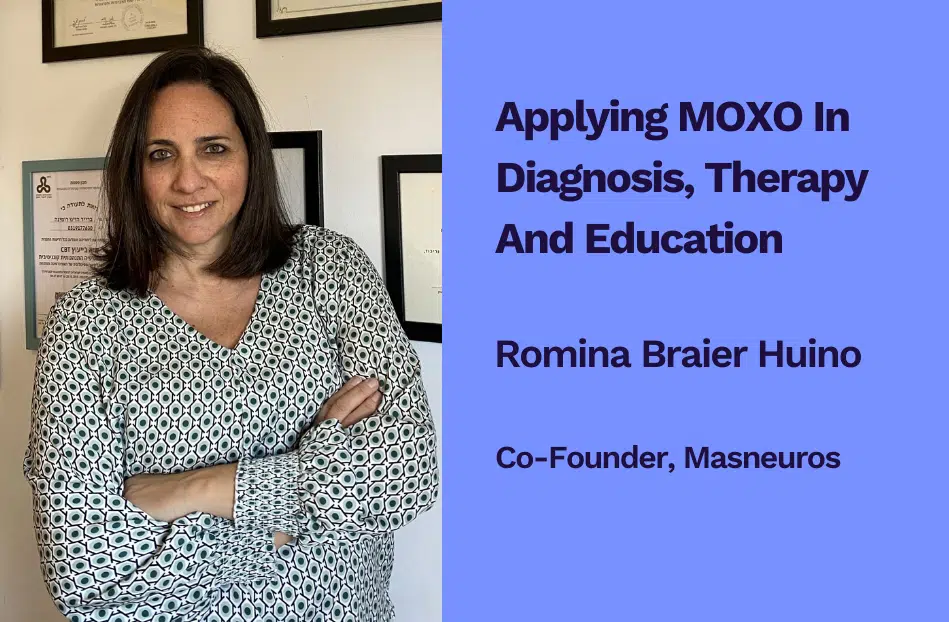How Masneuros Began
Romina Braier Huino’s journey is a testament to dedication and innovation in the field of special education. As an experienced therapist and didactic diagnostician, Romina has spent years transforming the lives of children with learning disabilities and ADHD. Her passion for helping these children began in Israel, where she worked for over 13 years in the special education department of the Ministry of Education. There, she became a renowned expert, dedicating her career to developing effective strategies for children with special needs.
In 2017, a new chapter of her life began when she moved to Spain. Four years later, Romina founded Masneuros with her partner Pilar Blanco, a neuropsychologist. Together, they created a sanctuary for children struggling with attention issues. At Masneuros, Romina combines her diagnostic skills with Cognitive Behavioral Therapy, providing comprehensive attention assessments and developing tailored behavioral programs for home and school environments. She and Pilar also share their expertise through lectures and training sessions, empowering educators with knowledge about attention disorders and effective classroom interventions.
Romina’s journey reflects a commitment not only to direct patient care but also to the broader educational community. Masneuros stands as a beacon of hope, integrating innovative technologies to enhance diagnosis and intervention, making the evaluation process more precise and efficient. Through their work, Romina and Pilar continue to make a significant impact, helping both children and mental health professionals navigate the complexities of attention disorders.

Discovering MOXO
When Romina first encountered MOXO during her didactic diagnostic studies in 2012, she immediately recognized its potential. She felt that MOXO was an excellent tool to include in her diagnostic battery. Upon completing her studies, Romina integrated MOXO into her evaluation process for each new patient. She starts her diagnostic journey with the MOXO test, considering it the «business card» of the patient. With the results in hand, she can clearly understand the patient’s profile, ask better questions, and make more informed decisions.
Streamlined Diagnosis
Romina works with two psychiatrists and a neurologist who refer patients to her for MOXO testing and retesting under medication, primarily children. The ability to conduct the test quickly shortens the diagnostic process, helping doctors decide whether to prescribe medication based on the retest results.
MOXO has significantly streamlined Romina’s diagnostic process. It helps her understand patients before analyzing all the data from other tests. MOXO Diagnosis reports serve as an excellent foundation for any intervention plan she develops, providing a rich information base for the reports and recommendations she issues to educational institutions.
For reports and children aged 7 to 12, Romina prefers presenting the developmental report to parents, as it clearly shows where their child stands in relation to their peers. When conducting test-retests, she finds the comparative report very convenient, as it is concise and clearly reflects the differences between tests.

Enhanced Therapy
In her clinic, Romina uses the MOXO test before starting CBT, even if the patient is not referred for attention disorders. The MOXO Profiler test interpretation provides her with information that she cannot obtain elsewhere, offering a comprehensive attentional profile covering the entire spectrum of attention. She zooms in on specific details, such as changes in the patient’s impulsivity over time and whether their work pace matches their age. These insights form the basis for her clinical intervention.
Educational Impact
Before using MOXO, Romina faced several challenges. Gathering information about the child in question often involved using questionnaires sent to schools and families. This sometimes led to confrontations with angry parents who disagreed with teachers’ assessments. To address this, Romina found that suggesting MOXO instead worked like magic. The test objectively shows the child’s attention capabilities, free from the subjective biases of teachers or parents. In instances where test results indicate attentional difficulties, this helps parents consider and accept that their child may have a difficulty that needs addressing.
Future Plans
Romina plans to continue using MOXO in her clinic, both for diagnosis and as a basis for interventions. She is highly impressed with how the MOXO Profiler has integrated into her therapy work and is actively working on implementing it more broadly in the education market in Spain as part of the medical examinations conducted on school students. These examinations assess the student’s physical abilities, weight, vision, and hearing. Romina is confident that the MOXO Profiler will add significant value to these assessments by generating attentional profiles for each student, helping to identify attention difficulties early and efficiently, and tailoring individualized instruction that takes these attention profiles into consideration.


